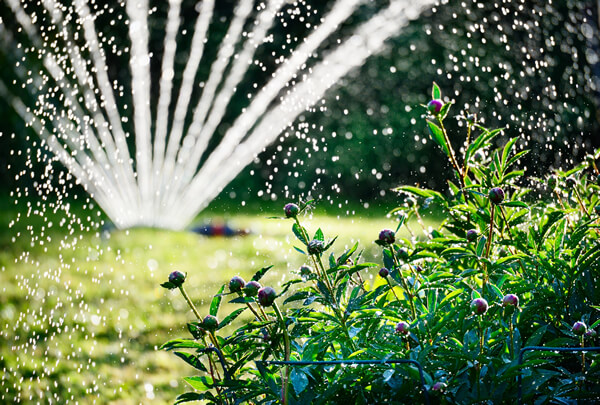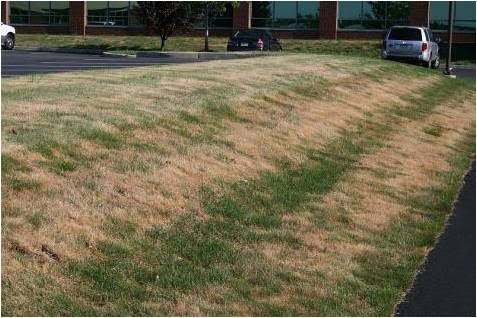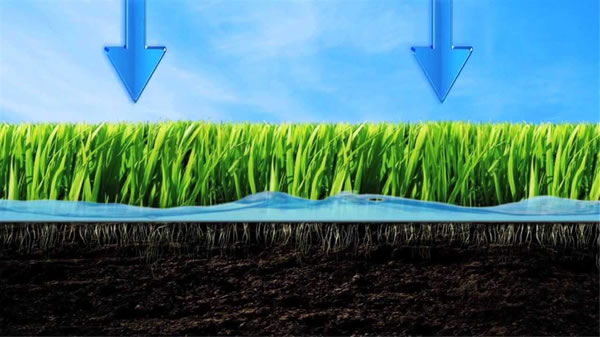Why do I need to be concerned about moisture levels in my lawn?
All plants need water to function. When water is in short supply the function of the plant can be affected
Certain weeds thrive in drought conditions. Not watering your lawn could be making your lawn weed issue worse
Healthy soil biology is essential for a healthy lawn. When moisture levels drop, so does the population of beneficial soil microbes
Some grasses tolerate drought more than others. Failure to provide water when your lawn needs it could result in more issues with weed grasses such as Poa Annua (annual meadow grass)
Wetting agents and moisture retaining products can drastically reduce the quantity of water you need to maintain a healthy lawn through periods of drought
How often should I water my lawn?
How much water does my lawn need?
Will my lawn recover after drought?
Will my lawn die if I don’t water?
How do wetting agents work?
If so, read on…
Lawn moisture management products briefly explained…
- There was a time when all we could do for our lawn in times of drought was add water
- A more modern approach to moisture management involves granular or liquid applications of wetting agents
- Wetting agents hold water in the root zone for longer, reducing water wastage
- Wetting agents are also effective in dealing with fairy-rings
- In periods of drought, soil can become hydrophobic meaning it won’t absorb water
- Drought conditions can benefit certain weed types
It is important to water your lawn in times of drought

What is a wetting agent?
A wetting agent is a specialised molecule which is used to reduce the surface tension of water. Surface tension is what forms water into a droplet. The fact that water has a high surface tension can be an issue when we want water to penetrate a surface or spread throughout another material – such as soil
How do wetting agents work?
Wetting agents are used to reduce the surface tension of water and thereby help it’s penetration and movement within the root-zone of your lawn
How are wetting agents applied to my lawn?
Typically, wetting agents come in a liquid form and would be applied to your lawn using a sprayer. Much like the sprayer we would use to apply weed control or moss treatments. Some manufacturers supply wetting agents in granular form where the liquid has been applied to a carrier which can then be applied using a spreader, like those we use to apply lawn nutrition. In this format the inert carrier would break down following application, releasing the wetting agent into the soil
How will wetting agents benefit me and benefit my lawn
Wetting agents will work in two ways to the benefit of your lawn. Firstly, if the surface of your lawn is very dry it can be difficult to get water to be absorbed. Wetting agents will aid penetration of any water applied to your lawn into the soil profile. Secondly as the surface tension of the water molecule is reduced, it can move laterally through the soil which holds the water in the root zone for longer and delays its drainage through the soil
Will wetting agents reduce the cost of watering my lawn?
The amount of water you need to apply to your lawn can be significantly reduced through the use of wetting agents. In addition, the time it takes for your lawn to become stressed in a period of drought can be extended through the use of a professional lawn wetting agent and therefore you can start watering later or you may even find that the rain has returned before you need to begin to water.
Are wetting agents essential?
Wetting agents have many uses. They might be used in the coatings industry to aid even distribution of pigments such as dyes or paint. We often use wetting agents when applying weed control as they break down the surface tension which helps the product be absorbed into waxy or hairy weed leaves. This relatively new lawncare technology is becoming extremely useful in the management of lawn drought issues too.
What is Selective Dry Patch and will a wetting agent help?
This condition causes your lawn soil to become hydrophobic. Hydrophobic soil repels water rather than absorbing it. If you have ever let a house plant or hanging basket dry out too much and then find that the water flows off the surface of the compost rather than soaking in, then you have seen how hydrophobic soil behaves. This is due to the surface tension of the water. A wetting agent will help against issues with Selective Dry Patch
What are Fairy Rings on my lawn?
Fairy rings can appear in lawns as an arc of dark green or brown grass or as a circle or semi-circle of toadstools on the surface. They are caused by fungi digesting organic matter under the surface. The dark green grass is a result of the nutrients released by the fungi as the organic matter is broken down. Often, they result in a hydrophobic area of soil which won’t absorb moisture and results in grass dying off. Wetting agents can be used to help the recovery of lawns suffering with fairy rings.
Does watering differ depending on the type of soil?
In short, yes. Different soil types have differing abilities to retain moisture. Sandy soils are more free draining, meaning any water passes through them more quickly. Clay soils hold on to water better but tend to become very hard, and cracks form once they are allowed to dry out. Rewetting clay soils can be very difficult. Soils with a higher content of organic matter will retain moisture for longer and help protect the lawn from drought stress. The frequency and amount of water needed can be influenced by the type of soil in your garden
How often should I water my lawn?
The answer here depends on a number of factors including the type of soil your lawn is growing in and the type of grass growing in your lawn. Certain grass types are more drought tolerant. Certain soil types are better at retaining moisture. A lawncare professional will be able to advise you on both these factors specific to your own garden. Typically, in a period of drought, water your lawn thoroughly, once a week.
How much water does my lawn need?
All living things need water to survive, and your lawn is no different. The amount of water you should give your lawn will depend on what you are hoping to achieve. In a period of extended drought your lawn will need watering weekly to keep your grass alive. If you want to keep your lawn green, then it will need more water than it needs simply to keep it alive. Read on for our watering guidance
Is watering my lawn bad for the environment?
In our opinion, it is not bad for the environment to water your lawn. In fact, lawns are great at absorbing atmospheric carbon and therefore it’s important that we do all we can to keep the alive and healthy. Remember that every molecule of water that exists today has always existed and always will. Watering your lawn doesn’t ‘use up’ water. That water eventually ends up back in the atmosphere from evaporation, or back in the water courses from drainage.
When is the best time of day to water my lawn?
You should avoid watering your lawn in the evening. This is because you want the grass leaf to dry as quickly as possible after it has been watered in order to reduce the risk of fungal issues. Lawn diseases such as Red Thread thrive in warm, damp conditions and stressed grass is more susceptible to a fungal disease attack.
Will watering my lawn in bright sunlight cause damage?
This is a common misconception. Watering in the heat of the day will not damage your lawn. If you have ever visited hot places like Florida, you will often see sprinklers running during the day.
Can you water your lawn too much?
In theory you could cause waterlogging by applying too much water to your lawn. Waterlogged soils have they air-spaces filled with water instead of air and this is very bad for the health of the soil over a long period of time. However, assuming that you are watering because we are in a period of drought then this excess water will soon be used up or drain away
How should I water a newly seeded lawn?
New seed needs a different watering regime to an established lawn. Watering little and often is the best way until seed becomes established. Water new seed daily for around 5 minutes for the first couple of weeks. Watering can then become less frequent but for longer periods in order to encourage deeper root development.
My grass is brown, does that mean it is dead?
In times of extended drought, a grass plant will begin to reduce the amount of water that it supplies to the grass leaf and stores water in the roots in order to keep itself alive. The leaf will turn brown, and it will appear that the grass plant is dead. It may possibly be dead, and you won’t know for sure until moisture returns to the root zone. If a grass plant had the issues to deal with, such as chafer grub or leather jacket damage, that has reduced its root development, then it may well die in a period of drought as it doesn’t have enough root left to retain the moisture it needs to survive.
Will my grass recover after turning brown?
Providing your lawn is in good condition, has a well-developed root zone and is not on overly compacted soil then it should be able to survive a short period of intensive drought and heat.
What can I do to reduce drought stress and the amount of watering my lawn needs?
If your lawn grows on soil which is not in optimum condition it is more likely to suffer from stress in times of drought. Stressed grass is more susceptible to disease attack, challenges with lawn pests and simply looks unattractive. In extreme conditions the lawn will die and not recover. This can result in big costs to put things right again. Ensuring your turf is in optimum condition carries huge benefits to reduce drought stress.
- Manage thatch issues – ensure the lawn is regularly scarified to reduce the build-up of organic matter at the surface which may prevent moisture reaching the root zone.
- Aerate your lawn regularly – compacted soils absorb less water in times of drought
- Focus on root development – grass plants with greater root density will have more access to available moisture
- Improve the soil structure – compost-based lawn dressings will add organic matter which holds on to moisture in times of drought
- Plan ahead – implement a cohesive plan each year to predict issues and prevent them from occurring.
- Raise your mowing height in times of drought stress – it reduces the effect of the sun’s rays on the soil surface and helps to capture night-time dew.
How do lawn professionals manage lawn water issues?
- Ensure your lawn is in the best condition it can be in
- Look after the health of the soil among with the length of the grass
- Don’t leave it too late before you start to water
- Get water quantity right, most people don’t water for long enough
- Use wetting agents to make any water available for as long as possible
How to correctly water your lawn
- Water in a morning or during the day. Never in an evening
- Use a good quality sprinkler with an even spray pattern
- Place a container on the lawn and time how long it takes for your sprinkler to fill it with an inch of water
- Each time you water your lawn, leave the sprinkler on for that amount of time to ensure your lawn has received enough water to get deep into the root zone.
- As lawncare professionals, we have access to industry leading products and technology that not only helps you achieve a wonderful, healthy lawn that you can be proud of but also products that help you to avoid longer term issues you may not even have been aware of.



 Established 2016
Established 2016



